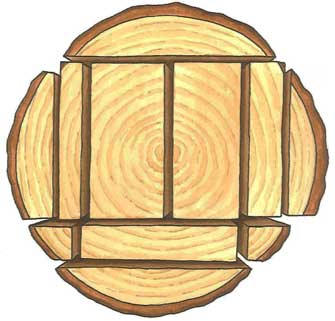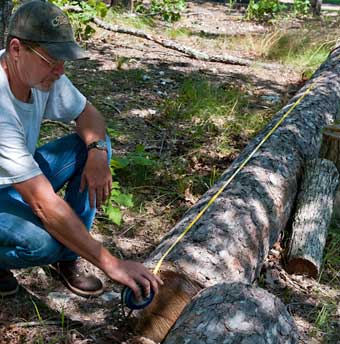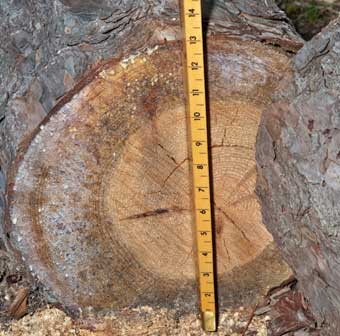 Foresters use a number of mathematical formulas to estimate the board feet of lumber in a cut log. Using one of these formulas, known as “log rules,” you, too, can estimate the amount of sawn lumber a log will produce. This can be useful, say, if you may want to estimate what you will owe the portable sawmill owner for sawing it up for you (since he probably will charge you per board foot). The estimate will get you close so that the final bill will not be a complete surprise.
Foresters use a number of mathematical formulas to estimate the board feet of lumber in a cut log. Using one of these formulas, known as “log rules,” you, too, can estimate the amount of sawn lumber a log will produce. This can be useful, say, if you may want to estimate what you will owe the portable sawmill owner for sawing it up for you (since he probably will charge you per board foot). The estimate will get you close so that the final bill will not be a complete surprise.
A log rule attempts to estimate the number of board feet of lumber in a log. (A board foot in its purest sense is a board 1″ thick, 12″ long and 12″ wide.) It is more difficult than you think, because kerf width will vary from saw blade to saw blade, waste will vary depending upon how the log is sawn, and each species of tree will vary in the amount of taper from the base of the log to the top. Log rules are based on mathematical estimates of the volume of a cylinder with taper adjustment, and a couple are even based on actually drawing board ends in a given size circle equaling the log diameter.
 Most log rules have been used to calculate the volume of commonly sized logs and printed in table form. You will find one for the International 1/4 Log Rule below. To use any log rule, you will have to take some measurements of the log.
Most log rules have been used to calculate the volume of commonly sized logs and printed in table form. You will find one for the International 1/4 Log Rule below. To use any log rule, you will have to take some measurements of the log.
Measure the length of the log and round it down to the nearest even foot. For example, if you have a 15’3″ log, use the 14′ long length in the log rule table. Most loggers will cut logs into lengths only an inch or two greater than the nearest even foot. Remember that the butt of a log usually is not sawn flat, so measure the shorter side of the log for length.
 Finally, measure the diameter at the TOP of the log. Always measure diameter “inside bark” – meaning that you don’t want to capture the bark thickness in your measurement.
Finally, measure the diameter at the TOP of the log. Always measure diameter “inside bark” – meaning that you don’t want to capture the bark thickness in your measurement.
Use your measurements with the attached table to determine the approximate number of board feet the log holds. The log in the above photos was 13 inches and 16′, so we estimate the log as having 115 board feet of lumber.
Tim Knight
| The board-foot contents of logs according to the International 1/4 Rule | |||||
| Diameter of log small end, inside bark | Length of log (feet) | ||||
| 8 | 10 | 12 | 14 | 16 | |
| Board feet | |||||
| 12 inches | 45 | 55 | 70 | 85 | 95 |
| 13 inches | 55 | 70 | 85 | 100 | 115 |
| 14 inches | 65 | 80 | 100 | 115 | 135 |
| 15 inches | 75 | 95 | 115 | 135 | 160 |
| 16 inches | 85 | 110 | 130 | 155 | 180 |
| 17 inches | 95 | 125 | 150 | 180 | 205 |
| 18 inches | 110 | 140 | 170 | 200 | 230 |
| 19 inches | 125 | 155 | 190 | 225 | 260 |
| 20 inches | 135 | 175 | 210 | 250 | 290 |
| 21 inches | 155 | 195 | 235 | 280 | 320 |
| 22 inches | 170 | 215 | 260 | 305 | 355 |
| 23 inches | 185 | 235 | 285 | 335 | 390 |
| 24 inches | 205 | 255 | 310 | 370 | 425 |
| 25 inches | 220 | 280 | 340 | 400 | 460 |
| 26 inches | 240 | 305 | 370 | 435 | 500 |
| 27 inches | 260 | 330 | 400 | 470 | 540 |
| 28 inches | 280 | 365 | 430 | 505 | 585 |
| 29 inches | 305 | 385 | 465 | 545 | 630 |
| 30 inches | 325 | 410 | 495 | 585 | 675 |





